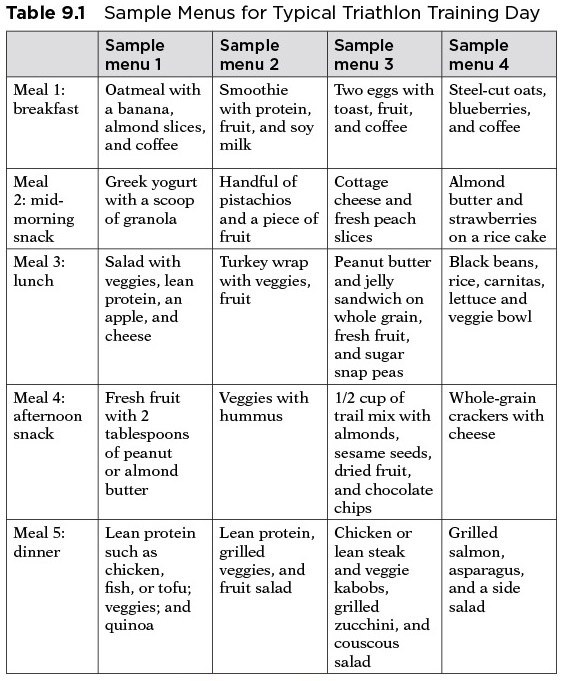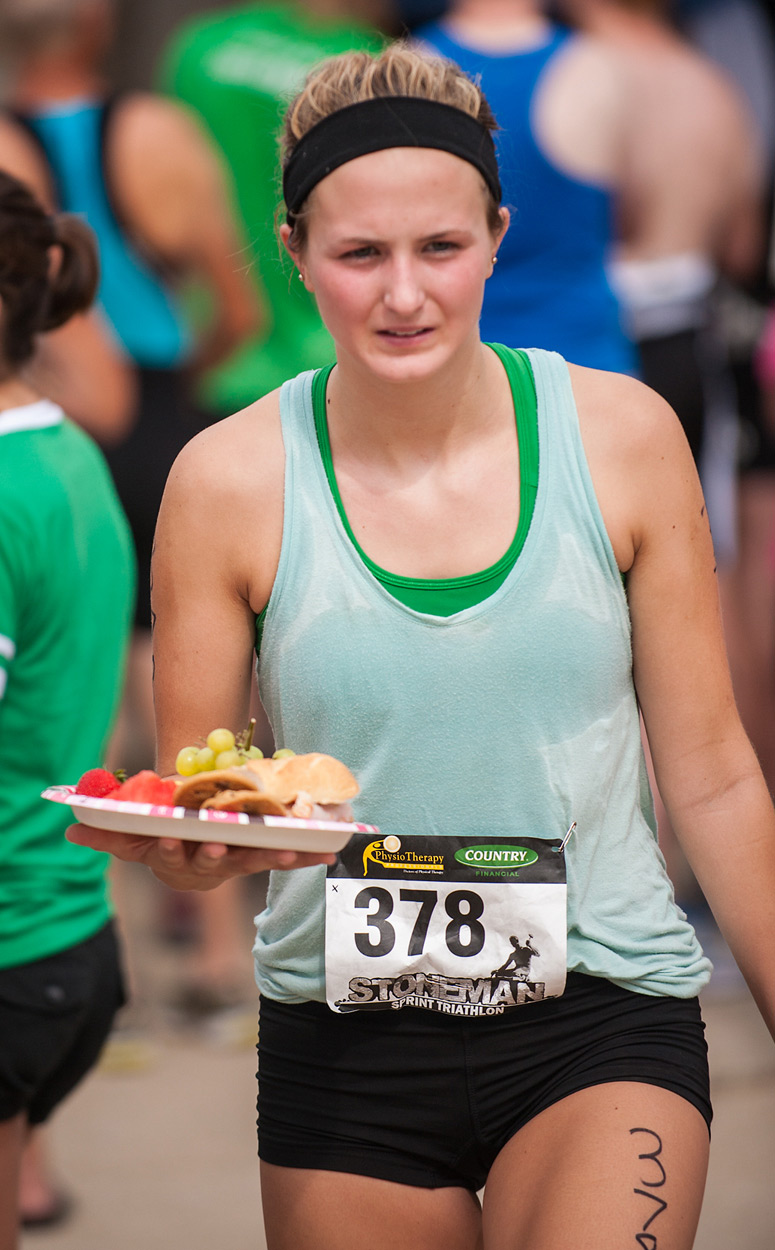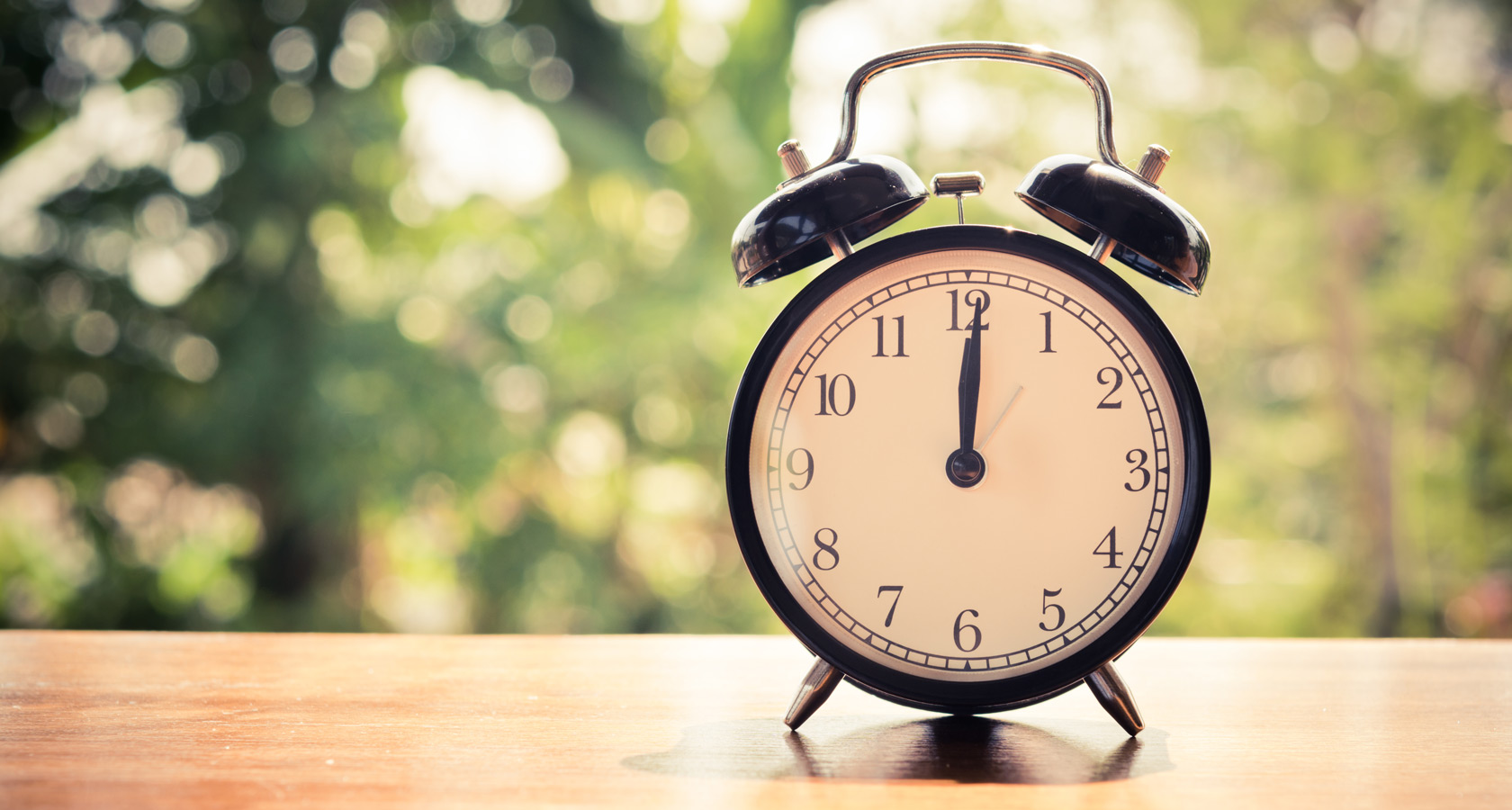How to Time Your Nutrition
It’s important to know when to take in calories during the day and in what form.
Fueling Throughout the Day Fueling Before & After a WorkoutFueling during a workout Fueling for race dayFueling post race
Fueling Throughout the Day
When it comes to fueling during your triathlon training, not all calories are the same. For instance, the number of calories in a banana may be equal to that in a mixed alcohol drink, but we would never recommend refueling with a cocktail after a workout. Consuming quality calories from real foods low in saturated fat and simple sugars is an ideal way to fuel and refuel your body. The body processes such foods more efficiently, and they normally hold a higher nutritional value and contain numerous vitamins and minerals that are essential for maintaining a healthy body. Although processed or man-made foods and supplements can be substituted during some meals, we recommend keeping those items to a minimum in your daily food consumption. We will address sports drinks and sports nutrition items such as gels, blocks and bars later.
As a triathlete, you need to understand how the food you eat is burned and converted to fuel or energy. Carbohydrate is a main source of energy in a triathlete’s diet, but as with other nutrients, the various forms of carbohydrate are not equal in how they fuel the body. All foods are assigned a number between 1 and 100 on the glycemic index (GI). The GI is essentially a way to rate how fast the body burns the food we eat as fuel. For example, white bread is assigned a relatively high number on the GI, meaning that it is turned into energy quickly and does not supply a long-lasting source of fuel. On the other hand, whole-grain bread is generally assigned a lower number on the GI, meaning that it is not digested quickly and therefore provides a slower-acting, longer-lasting source of fuel. Foods with a higher GI rating increase blood sugar level faster than those with a lower GI rating. For meals, we recommend focusing on consuming lower GI carbohydrate to provide longer-lasting fuel sources. During longer training sessions or during your event, fuel sources with a high GI index are more acceptable because you may be requiring quick and simple sources of calories. Sports gels, blocks and bars come into play here. These items are normally high in simple sugars and provide a quick boost of energy that normally lasts less than 45 minutes. Because these products are normally high in sugar, you should consume them with 4 to 6 ounces (120 to 180 ml) of water. Consuming them with sports drinks that are high in sugar can lead to an upset stomach or gastrointestinal distress.
Here are a few common low GI foods:
- Milk
- Yogurt
- Oatmeal
- Fresh fruit (oranges, grapefruits, plums, apples, pears, peaches, dried fruit)
- Granola
- Bars (made with whole grains, dried fruit and little added sugar)
- Whole-grain toast
- Beans
- Brown rice
- Lentils
- Peanuts
- Cashews
During training, we recommend taking the approach of consistently fueling yourself throughout the day by consuming a series of smaller balanced meals versus a few larger meals. By consuming five smaller meals consisting of lean protein, low GI carbohydrate, fruits and vegetables, you not only create a more consistent fueling platform for your body but also are able to insert workouts into your day without having to deal with a full stomach. Eating smaller, more consistent meals also helps keep your blood sugar levels in a more consistent range, which will help prevent the afternoon drowsiness that can come after eating a large lunch. See table 9.1 for sample daily menus that will keep your blood sugar level consistent and your energy up for your training.

In addition, hydrating yourself consistently in this format is just as beneficial. Instead of consuming large amounts of water at one or two times during the day, you can hydrate your body more effectively by sipping small amounts of water throughout the day. Keeping a water bottle close to you at all times will assist in this process, especially if you work at a desk or other location where water is not readily available or convenient to grab often.
Fueling Before and After a Workout
Fueling before and refueling after workouts is another important aspect of training that should not be taken lightly. If you have a habit of working out first thing in the morning before breakfast, you should consume a small amount of calories (150 to 250 calories) and water about 30 minutes before starting your workout. Because you were most likely sleeping for 5 to 7 hours before waking up and probably have not eaten in the past 7 to 9 hours, your body needs a little fuel to get it moving. Going into an early workout starving prevents your body from performing as it should. Moreover, the thought of being hungry can divert your concentration from your workout and technique performance. Some examples of a good snack are the following:
A handful of dry cereal and 6 ounces (180 ml) of water
- 1 tablespoon of peanut butter
- A banana or an apple
- An energy bar
- Small protein smoothie
After you finish your workout, try to eat a meal within 30 to 60 minutes. Your body needs to refuel so that it can continue to give you energy for the rest of the day. How you refuel should be consistent with the intensity and duration of the workout you just completed. If you complete an easy 30-minute bike ride, your calorie refueling needs will not be the same as when you complete a 60-minute aerobic run. Use the information about burning calories we spoke of earlier to determine how many calories you need to consume after your workout.
Note here that at times you may find yourself having to squeeze in a workout between previous commitments, therefore not allowing you to eat a solid meal. In these instances, having meal replacement bars and bottled water can buy you some time until you can get to a good meal. These items can be safely stored in desks, cars or gym bags. A processed food product would be a good choice in these circumstances. A poor choice would be not to eat at all and simply wait until you can get to a meal. Starving yourself in this fashion can lead to overeating, unwanted snacking or fatigue. When looking for the right bar, the product with the least processing and lowest level of sugar is the best choice. Bars with nuts, honey, sea salt, brown rice cereal, agave nectar, and chocolate chips are good. Many of the bars with ingredients that are more natural have 190 to 225 calories, 8 to 17 grams of fat, and 5 to 7 grams of protein.
Fueling During a Workout
The goal of eating and drinking during your workouts and racing is to replenish calories burned and hydration lost. If your workout lasts less than 90 minutes, you will likely not need to eat anything. Simply hydrating with water should be sufficient. During your training and racing you typically tap into one of two energy sources in your body. You draw energy either from glycogen stores or from fat stores. The human body typically has about 3,000 calories of energy stored as glycogen and 80,000 calories of energy stored as fat. You draw from these two reservoirs at different times. When you are exerting energy at or above your aerobic threshold, your body uses glycogen as energy. It can convert glycogen to energy fairly quickly, but it also uses this fuel fairly quickly. You can replenish glycogen calories with gels and blocks because, as we said earlier, these items are normally made of simple sugar. Be aware that gels and blocks normally offer only 75 to 100 calories and can be taken only about every 45 to 60 minutes. So if you’re burning 1,000 calories per hour and can replenish only 100 of those per hour, you can see that glycogen is not a sustainable source of fuel for the long term. Fat calories, on the other hand, are burned much more slowly and are available from a vast reservoir of fuel. Fat calories are not as quickly accessed, and converting them to energy takes longer. Fat calories are not a source of fuel you will try to replenish during a workout or event. Your body uses fat calories as a fuel source when it is operating below your aerobic threshold. For that reason and others, you can go longer during a workout at an easier pace.
Throughout this entire process of working out or racing, your body is using water either to help covert calories to energy or to cool the skin by creating sweat. Water is a vital element of your body, and for that reason we prefer it as a rehydration product to sports drinks, which normally contain unwanted sugar. Water can serve other purposes as well; you can use it to rinse sticky hands, to splash your face, or to cool your head or back. The trick to staying properly hydrated is to take small sips often, about every 2 1/2 to 5 minutes. By taking small sips, you allow your stomach to process what you have consumed and you are less likely to create that bloated, upset feeling in your gut. Knowing whether you are properly hydrated during your day is an easy task. When you urinate, note the color and smell. We know that this method may seem gross, but trust us here. Dark yellow and pungent urine is a good indicator you are dehydrated and should drink more water. Going all day without urinating is another sign you are likely dehydrated. If your urine is clear with no smell, you may be overhydrated, which can lead to the leaching of nutrients and minerals from your body. Ideally, you want your urine to be a very light yellow, and you should have the urge to urinate about once every 1 to 2 hours.
Other dietary trends or needs can affect how you consume calories and offer unique challenges to triathlon training. Trends like the paleo diet limit your caloric options and can prevent you from consuming the correct balance of nutrients and minerals required for training. Sure, most cavemen and cavewomen were skinny, but they were not swimming, biking, and running as a hobby. We suggest that you bypass trends such as these and focus on eating correct portions of real foods. Those who have food allergies or social issues with certain foods may find it beneficial to meet with a dietician. Vegetarians and vegans need to find appropriate ways to consume higher levels of protein and iron during training. These two essential elements in the bloodstream become building blocks to creating lean muscle.
Fueling for Race Day
“How do I fuel on race day?” is a question many athletes ask. You don’t want to go into a race with too much food in your stomach. If you do, you could end up with terrible GI distress. You also don’t want to go into a race underfueled and not have enough energy to complete the race. So how do you find the balance between too much and too little (which can result in what is known as bonking)? Let’s discuss race-day fueling.
Assuming that your event is a morning race, your dinner the night before should be simple and at a reasonable time, say 6:30 p.m. This dinner should not be a “carbo load”; it should be a typical well-balanced meal. This is not the time to experiment, so it’s wise to avoid anything new to your diet. Nothing is worse than waking up race morning with a stomachache. We also recommend you avoid red meat because it can be hard to digest and can lead to an unsettled and upset stomach on race morning. Chicken and pasta are always good go-to foods, or, if you are traveling, pizza can offer consistency that is relatively balanced in both carbohydrate and protein (just don’t eat the whole thing!).
On race morning, eat your breakfast about 3 hours before the start of your event to allow optimal digestion of your food and ideally produce a bowel movement. In terms of foods, stick with the basics; bananas, oatmeal, bagels, waffles, juice and coffee are all good options. We suggest you avoid dairy products because they can cause stomach distress. An hour before your event, you can snack on an energy bar and sip on some water to help you stay topped off in the nutrition and hydration department.
You should practice your prerace meal a few times during training. Wake up a little early on a weekend and pretend it is race day. Eat what you think you might on race morning, do your workout, and afterward evaluate how your meal affected your performance. If it worked well, great. Lock it down. If it did not feel right, try again next week. Never wake up race morning and try something new. We never do anything new on race day.
Fueling After a Race
 Proper refueling and hydration after your race is key to your recovery process. Drink plenty of water to rehydrate your body. You should also try to get in some sort of nutrition within the 30 minutes after the race. If you have a queasy stomach, try some water first. Then, about 25 minutes postrace, see whether you can tolerate a banana or apple with peanut butter or some crackers with cheese. You don’t need to eat a lot of food; even 100 to 150 calories will help. Within 1 to 3 hours after your race, assuming that your stomach has settled down, you can eat a small meal or snack with carbohydrate and protein. You don’t want to eat more than necessary, but you want to refuel for recovery. Here are a few examples:
Proper refueling and hydration after your race is key to your recovery process. Drink plenty of water to rehydrate your body. You should also try to get in some sort of nutrition within the 30 minutes after the race. If you have a queasy stomach, try some water first. Then, about 25 minutes postrace, see whether you can tolerate a banana or apple with peanut butter or some crackers with cheese. You don’t need to eat a lot of food; even 100 to 150 calories will help. Within 1 to 3 hours after your race, assuming that your stomach has settled down, you can eat a small meal or snack with carbohydrate and protein. You don’t want to eat more than necessary, but you want to refuel for recovery. Here are a few examples:
- Sweet potato
- Protein shake
- Protein bar
- Grilled chicken and avocado salad
- Veggie omelet and fruit
- Steak salad
Republished from "Train to Tri: Your First Triathlon" from Human Kinetics.


